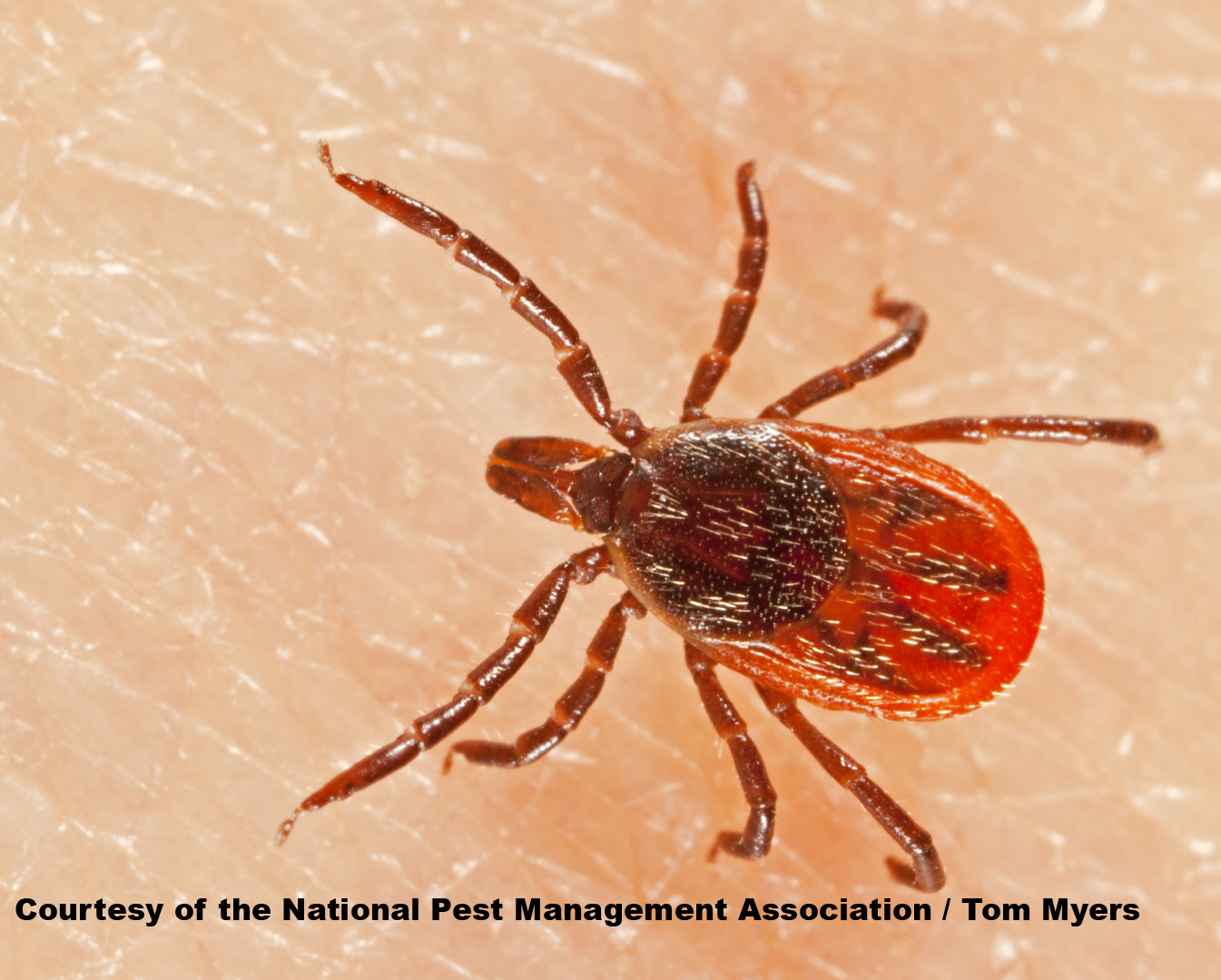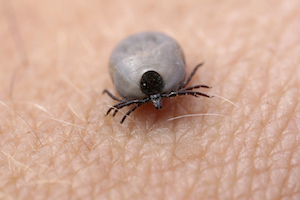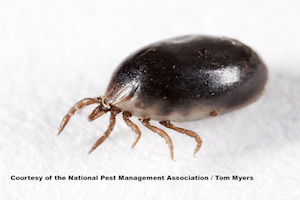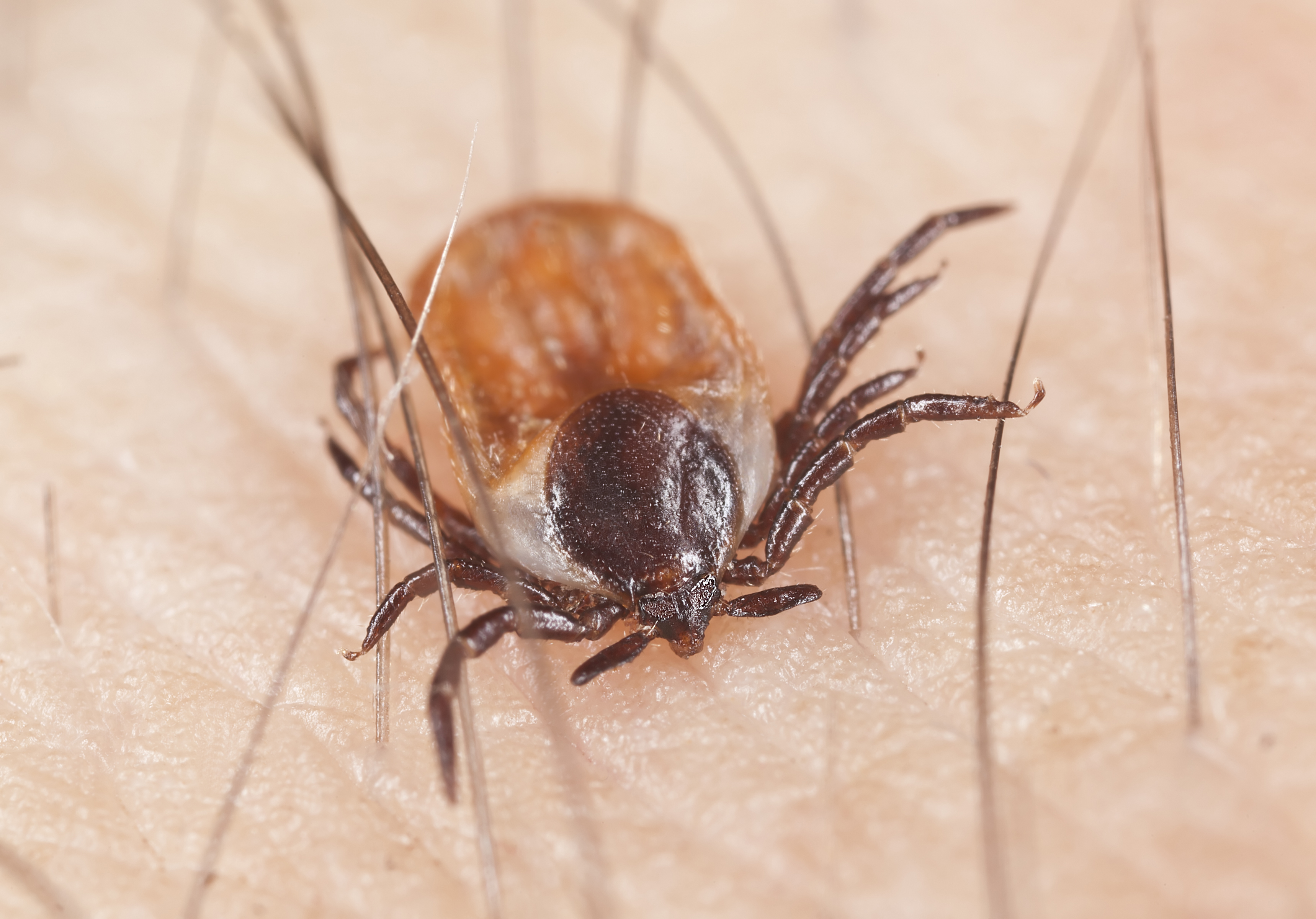Blacklegged (Deer) Ticks Ixodes scapularis

Blacklegged (Deer) Tick Identification
Color: Orange-brown with dark legs
Size: 1/8 "
Legs: 8
Antennae: No
Shape: Flat; broad oval
Region: Found primarily in the northeastern, mid-Atlantic, southeastern and north central regions of the U.S.
What is a Deer Tick?
The blacklegged (deer) tick is a notorious biting arachnid named for its dark legs. Blacklegged ticks are sometimes called deer ticks because their preferred adult host is the white-tailed deer. In the Midwest, blacklegged ticks are called the bear ticks. Deer ticks are found primarily in the northeastern, mid-Atlantic, southeastern, and northcentral United States but extend into Mexico. This tick is of medical importance because of its ability to transmit Lyme disease, anaplasmosis, human babesiosis, Powassan encephalitis, and more.
What Do Deer Ticks Look Like?
When unengorged (i.e. not filled with blood), the female blacklegged tick is roughly 1/8”, while male ticks are slightly smaller at about 1/16”. Both male and female deer ticks have flat, oval bodies, and are not hard-shelled. Female deer ticks are orangish brown in color except for their legs, mouthparts, and scutum (shield). Unengorged, their abdomen is a dark reddish-brown color but becomes darker after feeding on a host. Male deer ticks are reddish brown overall.
The blacklegged tick is longer than wide, and its sharply pointed toothed mouthparts are clearly visible from above. Newly hatched unengorged larvae are about 1/32” long and have 6 legs. Unengorged nymphs (baby ticks) are about 1/16” long and have 8 legs.
 Deer ticks are much smaller than dog ticks, and their bites are much more dangerous. Deer ticks are roughly 1/8”, about the size of a sesame seed, and have a flat, broad, oval shaped body. Dog ticks on the other hand are much larger, with females growing up to 1/2” after feeding on a host. Deer ticks are notorious for their black legs, which are in contrast with their light-colored bodies, while dog ticks are reddish brown in color with white and yellow markings. Dog ticks are found throughout the continental United States, as well as other regions of the world, while deer ticks are most common in the Northeast region of the United States. For more information on the differences between deer ticks and dog ticks, watch this video.
Deer ticks are much smaller than dog ticks, and their bites are much more dangerous. Deer ticks are roughly 1/8”, about the size of a sesame seed, and have a flat, broad, oval shaped body. Dog ticks on the other hand are much larger, with females growing up to 1/2” after feeding on a host. Deer ticks are notorious for their black legs, which are in contrast with their light-colored bodies, while dog ticks are reddish brown in color with white and yellow markings. Dog ticks are found throughout the continental United States, as well as other regions of the world, while deer ticks are most common in the Northeast region of the United States. For more information on the differences between deer ticks and dog ticks, watch this video.
 Deer ticks are much smaller than dog ticks, and their bites are much more dangerous. Deer ticks are roughly 1/8”, about the size of a sesame seed, and have a flat, broad, oval shaped body. Dog ticks on the other hand are much larger, with females growing up to 1/2” after feeding on a host. Deer ticks are notorious for their black legs, which are in contrast with their light-colored bodies, while dog ticks are reddish brown in color with white and yellow markings. Dog ticks are found throughout the continental United States, as well as other regions of the world, while deer ticks are most common in the Northeast region of the United States. For more information on the differences between deer ticks and dog ticks, watch this video.
Deer ticks are much smaller than dog ticks, and their bites are much more dangerous. Deer ticks are roughly 1/8”, about the size of a sesame seed, and have a flat, broad, oval shaped body. Dog ticks on the other hand are much larger, with females growing up to 1/2” after feeding on a host. Deer ticks are notorious for their black legs, which are in contrast with their light-colored bodies, while dog ticks are reddish brown in color with white and yellow markings. Dog ticks are found throughout the continental United States, as well as other regions of the world, while deer ticks are most common in the Northeast region of the United States. For more information on the differences between deer ticks and dog ticks, watch this video.
Blacklegged ticks prefer to hide in grass and shrubs while waiting for a passing host. They prefer vegetation located in transitional areas such as where forest meets field, mowed lawn meets unmowed fence line, or a foot trail through high grass or forest as these areas are where most animals travel sometime during each 24-hour period.
The other habitat most likely to harbor blacklegged ticks is the den, nest, or nesting area of its host such as that of skunks, raccoons, opossums, but especially the white-footed mouse. The white-footed mouse prefers woody or brushy areas. It nests in any place that gives shelter such as below ground, in stumps, logs, old bird or squirrel nests, woodpiles, buildings, etc.
During the winter, adult ticks feed primarily on the blood of white-tailed deer. In the spring, a female tick will drop off its host and will deposit about 3,000 eggs. Nymphs, or baby ticks, feed on mice, squirrels, raccoons, skunks, dogs, humans and birds.
A favorite feeding area for these ticks on humans is at the back of the neck, at the base of the skull; long hair makes detection more difficult. However, the ticks will usually crawl about for up to 4 hours or so before they attach. Then, a tick has to be attached for a period of 6-8 hours before a successful transmission can take place.
Blacklegged ticks or deer ticks are the main transmitters of anaplasmosis, babesiosis and Lyme disease. Lyme disease is a primary concern in the United States. Symptoms of Lyme disease include fever, headache, fatigue and a characteristic bull’s eye-shaped skin rash. Lyme disease can also affect joints, the heart and the nervous system if left untreated. If you have been bitten, deer tick removal should be performed as soon as possible.
The most common sign of a blacklegged tick problem is spotting one in your yard, on your body, or on your pet.
 To get rid of blacklegged ticks, keep grass cut low including around fence lines, sheds, trees, shrubs, swing sets and other difficult to cut locations. Remove weeds, woodpiles, and other debris that are attractive to mice as nesting areas, and leaf litter, which is attractive to ticks, especially the nymphs. Keep garbage can lids on tightly to discourage opossums, raccoons, and skunks from coming into the yard to raid garbage cans for food, as these animals all harbor the ticks that transmit Lyme disease. Discourage feeding birds because the seeds attract deer mice, the major reservoir host for the Lyme disease pathogen.
To get rid of blacklegged ticks, keep grass cut low including around fence lines, sheds, trees, shrubs, swing sets and other difficult to cut locations. Remove weeds, woodpiles, and other debris that are attractive to mice as nesting areas, and leaf litter, which is attractive to ticks, especially the nymphs. Keep garbage can lids on tightly to discourage opossums, raccoons, and skunks from coming into the yard to raid garbage cans for food, as these animals all harbor the ticks that transmit Lyme disease. Discourage feeding birds because the seeds attract deer mice, the major reservoir host for the Lyme disease pathogen.
For personal protection, use repellent containing permethrin or at least 20 percent DEET, and tuck pants into socks or boots when going into suspect areas. Always read and follow label instructions on repellents. Check children for ticks when they come into the house because it takes up to 4 hours, possibly longer, for the tick to start feeding. Wear light colored clothing that will make spotting ticks easier. Pets that go outdoors may increase the chance of the occupant’s encounter with these ticks, especially cats. Encourage the vet to check any pet’s blood to determine if they are carrying the Lyme disease spirochete.
To get rid of blacklegged ticks and their risks indoors, inspect clothing and skin when heading inside. Install a chimney screen to keep squirrels, raccoons, and birds away. The best way to remove a tick found attached to a person or pet is to firmly grasp it with a pair of tweezers as close to the skin as possible. Pull firmly but gently backwards until the tick pulls free. Do not touch the tick but save it in rubbing alcohol for later identification. Consult with a doctor immediately if there is a reaction at the bite site or if you believe you have contracted Lyme disease.
For deer tick removal on your property, contact a pest control professional, as regular inspection is important. You can find a certified professional near you with the helpful zip code search below.






